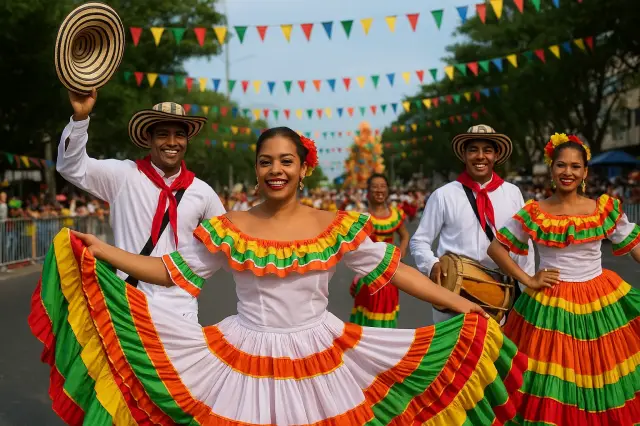The cultural anniversaries of 2026 in Colombia will be a meeting point between history, tradition, and modernity. Every year, the country celebrates dates that commemorate events, figures, artistic expressions, and cultural manifestations that have shaped its identity. In 2026, the calendar promises significant events that will strengthen national pride and the connection to the cultural roots of each region.
Below, we present a guide with the most relevant cultural events of the year, their meanings, and how Colombians can enjoy them in different parts of the country.
Most important cultural events in Colombia in 2026
Colombia boasts a rich calendar of cultural events, many of which are officially recognized by the Ministry of Culture and local governments. These commemorative dates not only preserve collective memory but also promote cultural tourism and heritage education.
Among the main cultural events of 2026 are:
January: start of traditional celebrations and festivals
January 6 – Three Kings Day: Although it is a religious holiday, in many regions such as Nariño and Boyacá it is combined with cultural expressions such as parades, music and dances.
Carnival of Blacks and Whites (Pasto): Intangible Cultural Heritage of Humanity, this carnival is celebrated from January 2nd to 7th and marks the beginning of the year with color, inclusion and diversity.
👉 Learn more about Colombian traditions .
February: art, love and culture
Festival of the Sweet Name of Jesus (Atlantic): Celebration with dances, parades and music that reflects the Caribbean heritage.
February 14 – Valentine's Day: Increasingly adopted in Colombia, it has taken on cultural nuances with music and art events in cities like Bogotá and Medellín.
March: Women's Month and Cultural Expressions
March 8 – International Women's Day: Beyond the social commemoration, exhibitions and cultural fairs dedicated to Colombian artists and writers are organized.
Holy Week (March 29 to April 5, 2026): In Popayán and Mompox, these celebrations are a World Heritage Site and a living example of sacred art and tradition.
April: Literature and Knowledge
April 23 – Spanish Language Day: Colombia, a country of renowned writers, celebrates this date with book fairs, recitals and tributes to Gabriel García Márquez.
👉 Also check out our article about Language Day in Colombia .
May: Afro-Colombian heritage and mestizaje
May 21 – National Afro-Colombian Day: An emblematic date to recognize the African influence on national identity, with events in Cartagena, Cali, Quibdó and Tumaco.
May 15 – Teacher's Day: With cultural events in schools and universities, the work of educators is celebrated.
June: art, music and folklore
Folkloric Festival and National Bambuco Pageant (Neiva): During the month of June , this event represents the soul of Huila and Andean folklore.
Farmer's Day: Several regions celebrate fairs and cultural exhibitions that promote rural life and peasant traditions.
July: Independence and national pride
July 20 – Independence Day: A key date for cultural events, parades, and performances of national music throughout the country.
Festival of the Colonies (Medellín): Brings together the cultural diversity of the Colombian territory in a single city.
August: heritage and oral tradition
August 7 – Battle of Boyacá: Commemorated with cultural parades and patriotic events.
Bogotá Summer Festival: A cultural and sporting space featuring local artistic displays.
Porro Festival (San Pelayo, Córdoba): Musical symbol of the Colombian Caribbean.
September: Love and friendship, Colombian style
Third Saturday of September – Love and Friendship Day: A celebration that has become part of popular culture with artistic activities, food festivals and concerts.
October: theater, film and performing arts
Ibero-American Theatre Festival of Bogotá (2026 edition): One of the largest events of its kind in the world, where international and local artists come together.
Halloween (October 31): In Colombia it has acquired a cultural aspect with children's festivals, costume contests and theatrical performances.
November: Caribbean music and heritage
Free Theater Jazz Festival (Bogotá): Celebration of national and international talent.
November 11 – Cartagena Independence: Heritage Festival with parades, music and troupes that in 2026 is expected to commemorate 215 years of freedom.
December: lights, carols and traditions
December 7 – Day of the Little Candles: One of the most beloved traditions for Colombians, where family and community come together around light and faith.
👉 Discover how Candle Day is celebrated in Colombia .December 16-24 – Christmas Novenas: Expression of popular religiosity with traditional music and gastronomy.
Importance of cultural anniversaries in Colombia
Colombia's cultural holidays are not just commemorative dates, but a reflection of the country's collective identity. Each event, parade, or festival is an opportunity to strengthen a sense of belonging and promote civic participation. Furthermore, they boost tourism, the local economy, and cultural exchange between regions.
The Ministry of Culture and the municipalities usually launch commemorative calendars each year that invite communities to actively participate in activities that preserve the historical memory and artistic expressions of the country.
How to take advantage of cultural anniversaries in 2026
To fully enjoy the 2026 anniversaries, we recommend:
Plan trips during long weekends associated with cultural celebrations.
Participate in fairs and festivals that promote regional diversity.
Follow the Ministry of Culture's social media accounts to find out about local calls for proposals and events.
Explore online cultural content , such as that of the Colombia Calendar Blog , where guides and articles about holidays, tourism and culture are published.
Cultural projection for 2026
The year 2026 will be filled with events highlighting Colombian talent, Indigenous and Afro-descendant heritage, and new forms of artistic creation. It will be a key year for strengthening regional identities and recognizing Colombia as a cultural powerhouse in Latin America.
